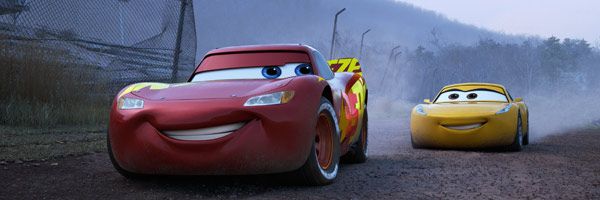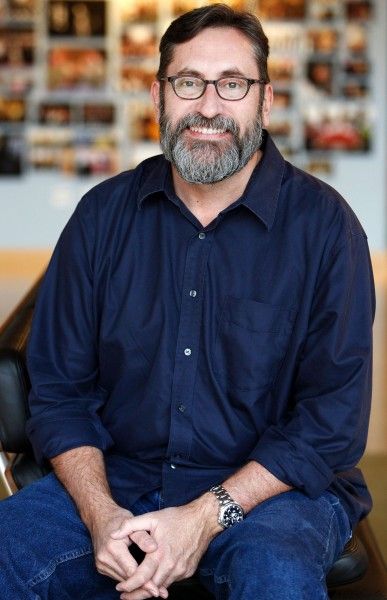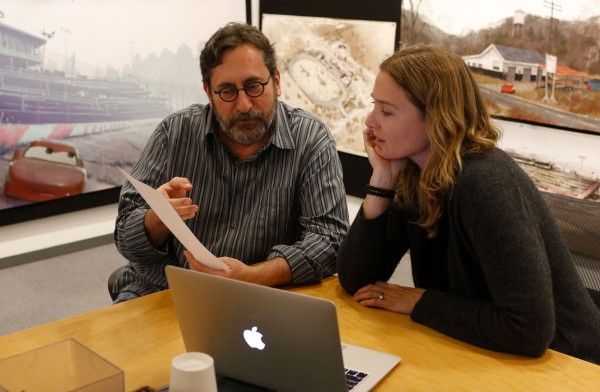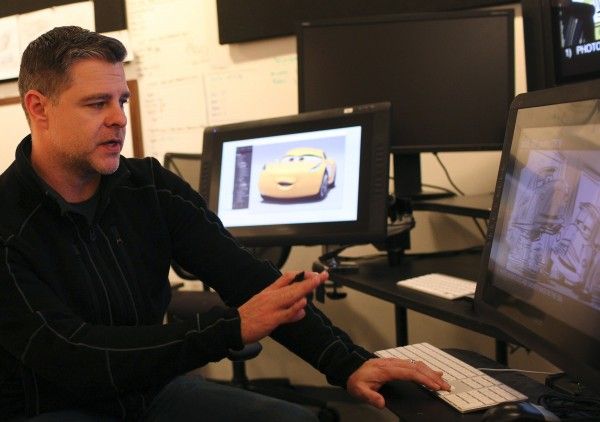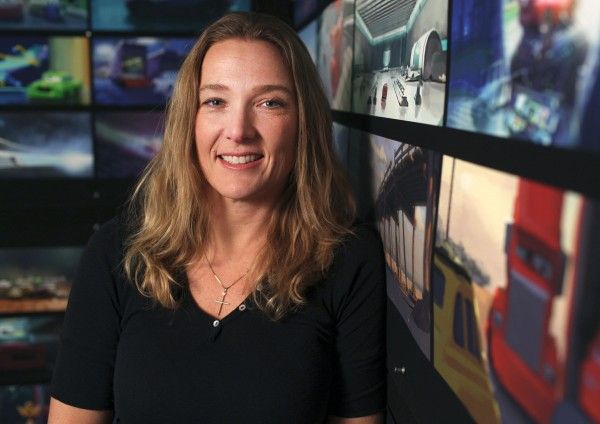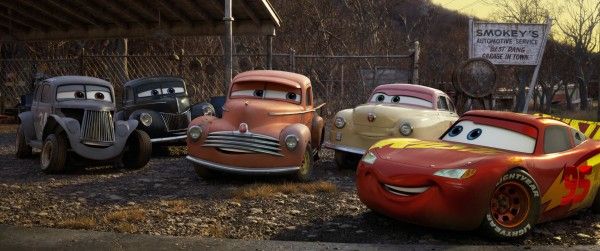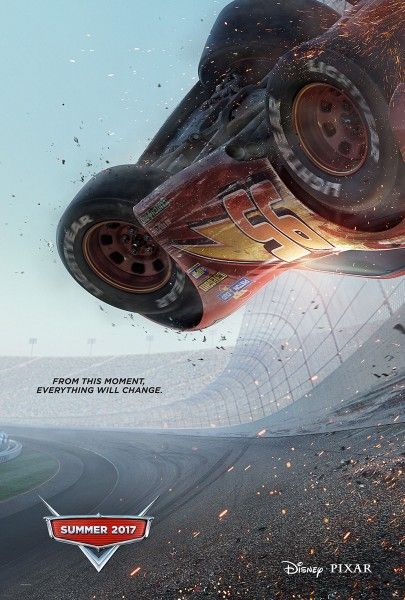Four years ago, I got the incredible opportunity to visit Pixar in Emeryville, Calif. for the first time, to do interviews for Monsters University, and the thing that most stood out to me when I was there was just how much inspiration you feel, surrounded by all of the artistic creativity going on within its walls. To say that I was excited to return, this time to get an early look at nearly 45 minutes of Cars 3, is a massive understatement.
As part of the experience, Collider got to spend the day at the Sonoma Raceway, participating in presentations about how the story, production design, animation and effects all came together to create what we’ll get to see in theaters on June 16th, as well as getting the opportunity to take a lap around the racetrack and go through pit stop training. We were also able to sit down with the writers who worked on the film – Mike Rich, Bob Peterson, Kiel Murray and Scott Morse – to talk about how having so many different voices can only make the story better, how big of an evolution it went through, how you know when you have the right ending, finding the right tone, fitting the new characters in with the already beloved ones, when Cruz went from a male character to a female character, and how the antagonist evolved.
Question: What’s it like to have so many different voices working on one movie, and then see it all put together in the finished product?
MIKE RICH: With this many voices, you end up with a better film. I truly believe that. I came from a live-action background, where it’s usually just me in a very solitary world. I saw, firsthand, how the Pixar process works, and it does work. Working with that many voices makes for a better story and a better film.
Where did it all start, as far as figuring out what this story would be?
RICH: You start off with recognizing where McQueen is, in his career and in his life. When we last saw him, he was in such a strong position. You have to look at it from the standpoint of, what can we do with him, at this particular point in his career, to make him vulnerable? The fact that he suddenly realizes that he’s not done, but he’s definitely past the half-way point and has to figure out a way to stay competitive is where it started.
How big of an evolution did this go through? Were there are a lot of changes?
BOB PETERSON: You can assume that anything we put on screen has gone through massive changes. That’s always part of the process. You make a statement, you watch it, you scratch your head and think it’s never gonna work, and then you find the happy accidents that lead you to other things. As long as you find one emotional tentpole, where you’re shooting for something that you know is going to be emotional and it works, then the movie starts settling down and you can work to it. But, there are times when nothing feels settled. They call it the Haunted Mansion syndrome, when you have all of these things swirling around your head and you don’t know what to grab, but then you poke at the dilemma of older athletes. That’s an emotional thing, in real life, where older athletes can’t do it as well and they, all of a sudden, remake themselves into something better. That was something that we could latch onto. Then, we had something to tack the story down to.
Endings also seem to take a huge journey in animated films. At what point do you know what your ending actually is, or does that also keep evolving?
KIEL MURRAY: I feel like it’s when everyone just feels it. You watch it so many times and change it so many times that there’s a point where everyone goes, “That’s it!”
PETERSON: It’s interesting, when you find things wrong, usually it means that there’s something in the set-up that’s incorrect. When the ending feels right, that usually means you’ve done most of your work leading up to that, so that you feel it.
How did you find the right tone for this story?
SCOTT MORSE: I think the apprehensive tone came out of looking at where McQueen is at in his career. The movie starts out very bright, and then when he realizes that he’s being faced with such a huge challenge, from out of left field, in his mind, his demeanor and the tone of the film changes to match the storm that he’s going through in his career. It felt natural to what McQueen’s character was asking for.
RICH: Once we decided on this particular story, there was a lot of meat on the bone and we didn’t want to short change that. We wanted to be authentic to it. We didn’t want to make a light version of that. If we were gonna walk down that road, we were gonna be true to it.
PETERSON: He fell from a great distance. He was at the top of his game, so it seemed natural that he’d get pretty depressed about that.
What are the challenges of writing for characters that people love while introducing new characters and finding their place in the story?
MURRAY: Especially creating a new character to insert into a line-up of already beloved characters, there’s a lot of pressure on that character owning their spot. It’s a lot of work and a lot of attempts at trying stuff until people feel it, laugh at it, or cry at it.
PETERSON: The test is, can you put two people on an elevator, strip out everything else, and laugh or enjoy their conversation? We wanted Cruz and McQueen to be funny, so you write a quarter-page thing and see if there’s anything there. You throw a lot of spaghetti at the wall, just to see what might work, and something usually comes out of it that you then expand.
At what point in the process did Cruz go from being a male character to a female character, and how did that change things?
MURRAY: It was very early.
MORSE: After our first screening, when we were looking at structural things, we realized that McQueen needed to be challenged by the biggest contrast that he could be challenged by, with the least likely friend that he could make. It just seemed more natural that he would be a she.
RICH: Then, they started auditioning all sorts of voices, and the minute we heard Cristela Alonso’s voice, it helped inform everything.
PETERSON: She’s funny, to begin with. She has a great power to her voice and she really cuts through. She can balance with Owen [Wilson], who’s his own special brand of force of nature, and she doesn’t get lost. And then, the icing on the cake was that she has an interesting vulnerability of her own and her own career story that validated what we were doing and informed Cruz’s character, which was great. It’s great to have the cast in your head when you’re writing. When you can hear their voice, they become a little muse for you while you’re writing.
How did your antagonist, Jackson Storm, evolve?
RICH: We wanted to make him a racer of the times, that was consistent with the technology of simulators. He was born with everything. He was born with speed and with every tool that he needed, and then some. We didn’t want him to become just a villain. We wanted him to be a racer that represented the era of the new generation coming in.
MORSE: What’s intriguing to me about him is that we were able to craft this athlete. Lightning McQueen is a consummate professional. He’s a champion and he knows it. So, to have another athlete come up and disregard him, to a certain extent, and not take him seriously, is one of the most frustrating things for Lightning McQueen. To not be taken seriously as an athlete, you bring villainy to that, if you’re the person being antagonized.
PETERSON: We talked a lot about the character and didn’t want him to be a mustache twirling villain, but a villain that sets up an even bigger villain inside McQueen, which is his own doubt of himself. And Cruz does the same thing, so he’s not in the film most of the second act. You see Storm’s beginning, but then he goes away, so McQueen’s own block for himself has to carry the antagonism.
What research really helped you the most with this?
RICH: Bob and I talked about how Kobe Bryant, after he injured his Achilles, had a Facebook post at 3am. I’ve never read anything like that, from a consummate professional athlete expressing his vulnerabilities about wanting to come back, but not knowing how he’ll come back. He was asking 12 questions that we layered into where McQueen was. And there was the adaptability that Michael Jordan showed with being willing to put in the work to recreate himself.
MURRAY: For Cruz, it was the combination of watching my own daughter, Cristela’s story, and the literature about the confidence gap and the studies on self-limiting and girls’ confidence issues. I got so into it, once I started reading, that I was telling everyone about it and sending it to everyone. That was impactful for me.
Cars 3 opens in theaters on June 16th.

